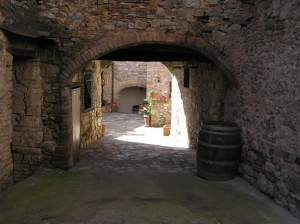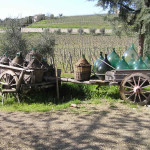Questo articolo è disponibile anche in:
![]() Français
Français ![]() Deutsch
Deutsch ![]() Español
Español ![]() Italiano
Italiano
For the part of the itinerary in the Sienese Chianti we can start from Siena and from here with the SR 222 reach Castellina in Chianti. Otherwise, continuing the itinerary of the itinerary of Florentine Chianti, from San Donato in Poggio, we reach Castellina in Chianti.
CASTELLINA IN CHIANTI
Castellina in Chianti is a splendid town situated in an equally splendid position dominating much of Chianti. Inhabited by the Etruscans. The Etruscan tombs in the area are evidence of this. Including the great mound of Montecalvario and the Necropoli del Poggino. In the Middle Ages Castellina belonged to Florence and was an important fortified place. It too was part of the Lega del Chianti. Today the ancient village has a spectacular medieval fortress and the remains of the walls. Definitely to go along the suggestive via delle Volte.
Nearby there are some interesting churches such as those of San Leonino in Conio and San Martino a Cispiano.

CASTELNUOVO BERARDENGA
The itinerary in the Sienese Chianti continues towards Castelnuovo Berardenga. In medieval times this town was a fortified village belonging to the republic of Siena. Its strategic position dominated the Ombrone valley. Few are the remains of the ancient fortifications of the village.
In the surroundings, the small fortified village of San Gusmè is set in a splendid landscape of vineyards. The Aiola castle near the town of Vagliagli, the Pieve di Santa Maria Maddalena in Pacina and the Certosa di Pontignano. In the territory of Castelnuovo Berardenga there is also the famous hill of Montaperti where on 4 September 1260 a famous and bloody battle was fought between the Sienese and the Florentines who “made the Arbia colored in red” (Dante Alighieri, Inferno, X, 85-86 ).

GAIOLE IN CHIANTI
Continuing our itinerary we arrive in Gaiole in Chianti, a village nestled along the course of the Massellone stream. The surrounding countryside is a succession of vineyards and olive groves. We are in one of the most beautiful landscape areas of the Chianti area.
This village was born in this unusual position because in the Middle Ages it was the seat of an important market. In this period, together with Castellina in Chianti and Radda in Chianti, Gaiole was also part of the Chianti League. Around the village there are two interesting attractions. The first is the parish church of Santa Maria a Spaltenna which dates back to the first half of the XII century. The second attraction is the castle of Vertine, a village fortified by a robust tower.
A few kilometers away from Gaiole is the spectacular Brolio Castle. Surrounded by splendid vineyards, this castle belonged to Baron Bettino Ricasoli in the 19th century. And still today it belongs to its descendants. However, this area is full of historic castles, churches and ancient monasteries. Among the most beautiful castles, those of Meleto and Cacchiano. While among the religious buildings, the churches of San Giusto in Salcio and San Polo in Rosso and the ancient Badia a Coltibuono are worth a visit.

RADDA IN CHIANTI
The itinerary in the Sienese Chianti continues towards Radda in Chianti. This ancient Chianti village is located on a hill overlooking the Pesa and Arbia valleys.
The village retains its medieval plan and parts of its ancient fortifications. Here excellent wines and an oil of great value are produced. The town belonged to Florence since 1203 and was the capital of the Chianti League in the Middle Ages. In the historical center, which has an elliptical shape, there is the Palazzo del Podestà with a facade decorated with coats of arms of the ancient podestàs.
In the surroundings of Radda it is worth visiting the village of Volpaia. A small fortified village immersed in the Chianti vineyards and olive trees countryside. There are the remains of towers and walls and the beautiful building of the Commenda di Sant’Eufrosino. In the surrounding countryside there are beautiful examples of Tuscan farmhouses and the Romanesque church of Santa Maria Novella.
The itinerary of the Florentine Chianti.
Questo articolo è disponibile anche in:
![]() Français
Français ![]() Deutsch
Deutsch ![]() Español
Español ![]() Italiano
Italiano

















